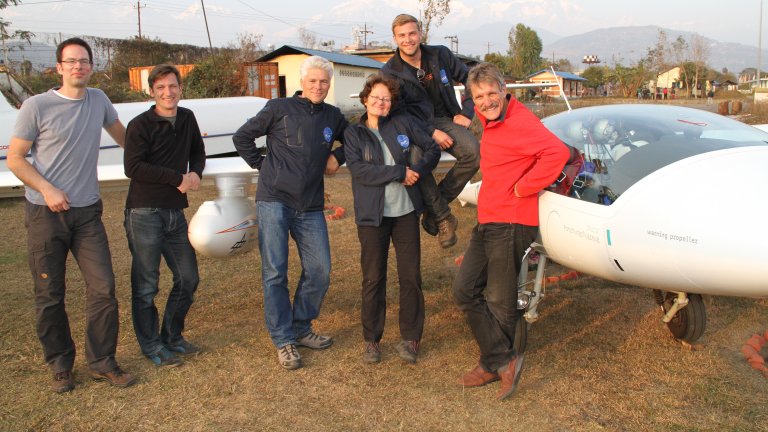
Flying over Mount Everest in a Glider
“Mountain Wave” was the name given to the project that explored the turbulences over the world’s highest mountain range, the Himalayas, for the first time in the fall of 2013. Two S10-VT motor gliders were used for the flyover. The gliders are the premium-product of the aircraft manufacturer Stemme from Strausberg. They had been equipped with measuring devices and sensors of the German Aerospace Center, the University of Applied Sciences Aachen and the Australian Flinders University. And who sat in the cockpit of one of the gliders?
Phillip Scheffel, Head of Research at Stemme in Strausberg, gushes over his top-notch product, the motor glider S10-VT: “What a Ferrari is to car enthusiasts, the S10-VT is to recreational or competitive glider enthusiasts.” The machine or “specimen”, as aircraft manufacturers call it, has a wingspan of 23 meters. And as a special highlight it has a foldaway engine; this propeller was conceived by company founder Reiner Stemme in the 1980s, and it completely disappears in the body of the aircraft when deactivated by the pilot.
The Stemme AG, together with its subsidiary development company Stemme GmbH & Co. KG and its marketing company ECARYS GmbH, has successfully filled a niche market in the private sports sector with its S10-VT and the somewhat smaller S6 for years. Around 240 motor gliders by Stemme are currently in use all over the world and are serviced, throughout their entire life span, in the base in Strausberg. The main market lies in the USA.
A person who is not only flying the “Stemme-Ferrari” on a daily basis, but is also using it to break record after record, is Klaus Ohlmann. After an Andes-flyover, the flying ace wanted to glide over all of the peaks of the Himalayas with an altitude of over 8000 m in just five hours. Of course he used his own Stemme S10-VT!
Mission in the Himalayas
The S10-VT’s huge advantage during high-altitude flights resides in its turbocharger engine. As almost no other comparable engine, it still operates steadily at altitudes between 3000 and 4000 meters above sea level. “These are the altitudes that have to be reached in order to get into the wavelike wind formations suitable for gliding,” explains Scheffel, who flies himself. Once these altitudes are reached, the excellent gliding characteristics of the S10-VT can be used to their fullest extent.
After the idea of a “Mountain Wave Project” had been conceived, the record-chaser Klaus Ohlmann and co-initiator René Heise, meteorologist and Vice-President of Berlin’s Aviation Society, had to secure the financing. Several private investors and the association of enthusiasts “Stemme Aviators e.V.” contributed to the project.
Soon after, the German Aerospace Center in Berlin-Adlershof entered the project through a research assignment. The German Aerospace Center had developed an optical measuring method for aerial reconnaissance and its baptism by fire was the measuring of the Himalayan topography. Furthermore, the University of Applied Sciences Aachen contributed to the project by providing a fully equipped laboratory version of the S10-VT, which the University had purchased three years prior from Stemme. Quite unexpected but very welcome was the interest the Flinders University from the Australian city of Adelaide showed in the project. Eventually, Flinders provided a measuring sensor. An alliance for the mission in the Himalayas had been forged!
Success all along the wave
Thanks to the solid preparations, the perfect organisation and logistics, as well as the extraordinary technical characteristics of both involved Stemme S10-VT gliders, the research and world-record-breaking undertaking was a resounding success. Among other things, the aerial waves above the world’s highest mountain range and their influence on civilian aviation have been studied for the very first time. The project also yielded insights into the routes of and causes for air pollution in South China and Tibet.
Phillip Scheffel pointed to the only fly in the ointment: “I would have loved to fly along, but unfortunately it was impossible due to organisational reasons.”